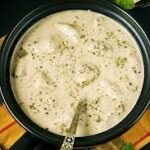1. Introduction
White chicken, with its creamy and flavorful sauce, requires careful cooking to achieve the perfect texture and taste. The choice of pan plays a crucial role in ensuring even cooking, preventing sticking, and enhancing the flavors. This article will help you choose the best pan for cooking white chicken and provide tips on how to use and maintain it.
2. Why the Right Pan Matters
Choosing the right pan for cooking white chicken is essential for several reasons:
- Even Cooking: A good pan ensures that the chicken cooks evenly, preventing any undercooked or overcooked spots.
- Flavor Development: The right pan can help develop and retain the flavors of the chicken and the sauce.
- Ease of Cooking: Using an appropriate pan makes the cooking process smoother and more enjoyable.
- Cleaning: The right pan can make cleaning up easier, reducing the time and effort needed after cooking.
3. Factors to Consider When Choosing a Pan
Material
The material of the pan affects heat conduction, cooking efficiency, and the final outcome of your dish. Common materials include stainless steel, cast iron, non-stick, enameled cast iron, and copper.
Size and Shape
- Size: Choose a pan that is large enough to hold all the chicken pieces without overcrowding. Overcrowding can lead to uneven cooking.
- Shape: A wide, shallow pan is ideal for cooking white chicken as it allows for better heat distribution and easier stirring.
Heat Distribution
A pan with good heat distribution ensures that the chicken cooks evenly. Pans with poor heat distribution can cause hotspots, leading to uneven cooking.
Ease of Cleaning
Consider a pan that is easy to clean, especially if you’re using sticky or creamy sauces. Non-stick and enameled cast iron pans are generally easier to clean.
Durability
Investing in a durable pan ensures that it will last for years, providing consistent results every time you cook.
4. Best Pans for Cooking White Chicken
Stainless Steel Pans
Pros:
- Excellent heat distribution
- Durable and long-lasting
- Non-reactive, preserving the flavor of your dish
- Can handle high heat
Cons:
- Can be difficult to clean if food sticks
- Requires more oil or butter to prevent sticking
Cast Iron Pans
Pros:
- Superior heat retention and distribution
- Can go from stovetop to oven
- Adds a unique flavor to the dish
- Extremely durable
Cons:
- Heavy and difficult to handle
- Requires seasoning and maintenance
- Can be reactive with acidic ingredients
Non-Stick Pans
Pros:
- Easy to clean
- Requires less oil or butter
- Food releases easily
Cons:
- Less durable than other materials
- Can’t handle very high heat
- Coating can wear off over time
Enameled Cast Iron Pans
Pros:
- Combines the benefits of cast iron with a non-reactive surface
- Easy to clean
- Excellent heat retention
Cons:
- Heavy
- Can be expensive
- Requires careful handling to avoid chipping the enamel
Copper Pans
Pros:
- Superior heat conductivity
- Quick and even heating
- Visually appealing
Cons:
- Expensive
- Requires regular maintenance to keep the shine
- Can be reactive with certain foods unless lined with another metal
5. Comparing Different Pan Types
When comparing different pans, consider your cooking style, budget, and maintenance preferences. Stainless steel and cast iron are great for durability and heat retention, while non-stick and enameled cast iron offer ease of cleaning. Copper provides the best heat conductivity but comes with a higher price tag and maintenance requirements.
| Pan Type | Heat Distribution | Durability | Ease of Cleaning | Maintenance | Cost |
| Stainless Steel | Excellent | High | Moderate | Low | Moderate |
| Cast Iron | Excellent | High | Low | High | Low |
| Non-Stick | Good | Moderate | High | Low | Low |
| Enameled Cast Iron | Excellent | High | High | Moderate | High |
| Copper | Superior | High | Moderate | High | Very High |
6. Tips for Using and Maintaining Your Pan
- Preheat Properly: Always preheat your pan before adding the chicken to ensure even cooking and prevent sticking.
- Use Appropriate Utensils: Avoid using metal utensils on non-stick and enameled cast iron pans to prevent scratching.
- Season Cast Iron: Regularly season your cast iron pans to maintain their non-stick surface and prevent rusting.
- Clean Promptly: Clean your pan soon after cooking to prevent food from sticking and becoming difficult to remove.
- Avoid High Heat on Non-Stick: Do not use high heat on non-stick pans to prevent damaging the coating.
7. Frequently Asked Questions (FAQs)
Q: Can I use a non-stick pan for cooking white chicken? A: Yes, a non-stick pan is suitable for cooking white chicken, especially if you prefer easy cleanup and less oil usage. However, it may not provide the same depth of flavor as stainless steel or cast iron.
Q: How do I prevent chicken from sticking to the pan? A: Ensure the pan is properly preheated and use enough oil or butter. For stainless steel pans, wait until the chicken naturally releases from the pan before attempting to turn it.
Q: What is the best pan for high-heat cooking? A: Cast iron and stainless steel pans are best for high-heat cooking due to their durability and excellent heat retention.
Q: Can I use the same pan for cooking and serving? A: Yes, enameled cast iron and copper pans are attractive enough for serving directly from the pan, adding a rustic touch to your table setting.
8. Conclusion
Choosing the best pan for cooking white chicken can significantly enhance your culinary experience. Whether you opt for the durability of cast iron, the convenience of non-stick, or the superior heat conductivity of copper, selecting the right pan will help you achieve perfectly cooked white chicken every time. Consider your cooking style, maintenance preferences, and budget when making your choice, and follow the tips provided to maintain your pan for long-lasting performance. Happy cooking!










